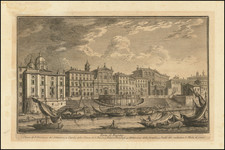The Most Important 19th Century Plan of Rome -- From Rome’s First Modern Census.
Stunning 4-sheet wall map of the Eternal City, originally produced as part of Rome's first modern census.
Published by the Census Directorate, the plan is an essential historical document in Rome's long history. It folds into its original red slipcase, beautifully preserved with a gilt-embossed coat-of-arms of Pope Pius IX on the cover. The map was published in 1866, the same year Pius chaired his first Vatican Council as pope.
The map was produced from the data derived from Rome's first modern census and preceded the city's elevation to Italy's new capital. The first edition of the map was published in 1829 on the order of Cardinal Cesare Guerrieri. Guerrieri was the president of the congregational council established in 1818 to meet Pope Pius VII's call to count the citizens of Rome. Known as the urban cadastre (formal censuses were not instigated in Italy until 1871), the process was a massive undertaking that took four years to complete (1822).
Guerrieri issued a directive that the many hand-drawn maps compiled and used in the counting process be combined into a single great plan of Rome, resulting in the production of the first state of this iconic map. A second state was then published in 1854, adding significant new urban elements, such as the iron bridge next to Ponte Rotto. Twelve years later, the map was amended again, this time with far more significant updates.
The census map quickly became renowned for its accuracy and detail, with even the finest features appearing clearly. Many of the mapping techniques applied in this map were originally pioneered in the monumental and genius city plan published by Giambattista Nolli in 1748. Like Nolli's iconic creation, the census map applies a technique of hachuring and color-coding elements that allow viewers to easily distinguish buildings from open spaces like streets and piazzas.
On the present example of the map, buildings are illustrated as hatched spaces, while streets and piazzas are left uncolored and thus contrast sharply with the architecture. The plan includes most of Rome's many historical monuments but focuses on the many churches scattered throughout the city. During the Baroque period (circa 1600-1800), most of Rome's active churches were increasingly interconnected by the urban infrastructure so that streets almost seem like arteries, leading from one church to the next. The city's most famous monuments are shown as architectural top plans, once again evoking the brilliant legacy of the Nolli Map.
The current example is the third and final state of this map, which is also the most accurate depiction of Rome created in the 19th century. Many features not only identify this example as the 1866 edition but also demonstrate the efforts made to keep the map up-to-date. The first part of the Via Nazionale is shown, which was only completed the same year this map was published. Modern elements, such as railroads, are added for the first time, with the train lines to Termini clearly shown (completed in 1862), while the Passenger Hall - built only in 1867 does not appear on the map. Other recently constructed features on the map include the iron bridge on San Giovanni dei Fiorentini (built in 1863), Piazza Matai (1864), and the associated tobacco factory (1863).
Several notable updates between 1829 and 1866 illustrate changes to historic Rome. Most notably, the Monte Palatino has evolved from a relatively unillustrated open area to a meticulously detailed and annotated depiction of its ancient architecture and gardens. In a completely different way, the east bank of the Tiber next to the Piazza del Popolo appears to have been converted from a marshy river bank to a modern promenade with a small boat landing.
Rarity
Because of the contemporary importance of the map, a number of examples are held in Italian municipal archives, including those in Rome and the Achille Bertarelli archives held in Milan.
However, in the modern antiquarian market, the map is quite rare, especially with the contemporary papal slipcase. OCLC does not list any institutional holdings of this important map, and only a single example of the 1866 edition of this map has been offered on the private market in recent years.












![[ Ancient Rome ] Urbis Romae Situs Cum IIS Quae Adhuc Conspiciuntur Veter Monumet Relquiis Pyrrho Ligiorio Neap Invent. Romae M. D. LXX](https://storage.googleapis.com/raremaps/img/small/96880.jpg)

![[Rome] Rom. Rioni, Regionem od. Abtheilungen Rom's](https://storage.googleapis.com/raremaps/img/small/91898.jpg)
![[Rome and it Ancient Water Supply] Partis. Latii A. Roma Labicum Usque Descriptio Dissertationi Ideaquis etAquae Ductibus Veteris Romae Praemissa. authore Raph Fabretto . . . .](https://storage.googleapis.com/raremaps/img/small/88290.jpg)
![[Rome] Veduta del Ponte e Castello Sant'Angelo](https://storage.googleapis.com/raremaps/img/small/91122.jpg)